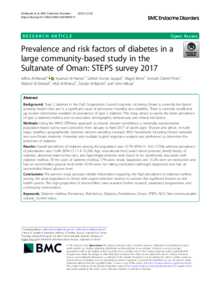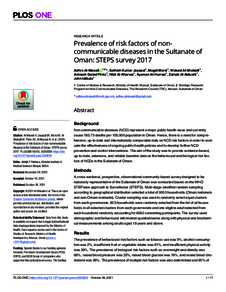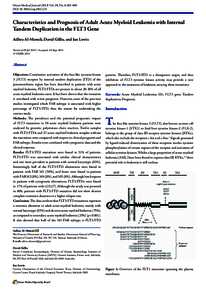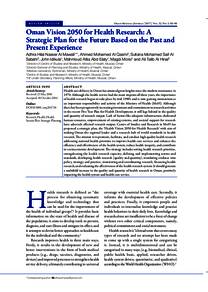Document
Prevalence and risk factors of diabetes in a large community-based study in the Sultanate of Oman : STEPS survey 2017.
Identifier
DOI: 10.1186/s12902-020-00655-9
Source
BMC Endocrine Disorders. v. 21, 1, 42
Contributors
Al-Harrasi, Ayaman., Author
Jayapal, Sathish Kumar., Author
Morsi, Magdi., Author
Pinto, Avinash Daniel., Author
Al-Shekaili, Waleed., Author
Al-Kharusi, Hilal., Author
Al-Balushi, Zainab., Author
Idikula, John., Author
Country
United Kingdom.
City
London
Publisher
BioMed Central Ltd.
Gregorian
2021-12-01
Language
English
Subject
English abstract
Background: Type 2 diabetes in the Gulf Cooperation Council countries, including Oman, is currently the fastest growing health crisis and is a significant cause of premature mortality and disability. There is currently insufficient up-to-date information available on prevalence of type 2 diabetes. This study aimed to assess the latest prevalence of type 2 diabetes mellitus and its associated demographic, behavioural, and clinical risk factors. Methods: Using the WHO STEPwise approach to chronic disease surveillance, a nationally representative population-based survey was conducted from January to April 2017 of adults aged 18 years and above. A multi-stage, stratified, geographically clustered random sampling surveyed 9053 households including Omani nationals and non-Omani residents. Univariate and multiple logistic regression analysis was performed to determine the predictors of diabetes. Results: Overall prevalence of diabetes among the population was 15.7% (95% CI: 14.0–17.5%) whereas prevalence of prediabetes was 11.8% (95% CI: 11.4–12.2%). Age, educational level, raised blood pressure, family history of diabetes, abnormal waist-to-hip ratio, and hypertriglyceridemia were found to be significantly associated with diabetes mellitus. Of the cases of diabetes mellitus, 17% were newly diagnosed and 13.2% were on medication and had an uncontrolled glucose level while 55.5% were not taking medication (although diagnosed) and had an uncontrolled blood glucose level. Conclusions: The present study provides reliable information regarding the high prevalence of diabetes mellitus among the adult population in Oman with urgent attention needed to address this significant burden on the health system. The high proportion of uncontrolled cases warrants further research, awareness programmes, and community interventions.
ISSN
1472-6823
Resource URL
Category
Journal articles





